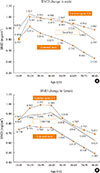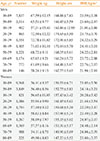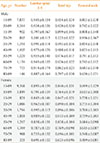1. Keene GS, Parker MJ, Pryor GA. Mortality and morbidity after hip fractures. BMJ. 1993; 307:1248–1250.
2. Lee SR, Kim SR, Chung KH, Ko DO, Cho SH, Ha YC, Kim BG, Kim JR, Kim SY. Mortality and activity after hip fracture: a prospective study. J Korean Orthop Assoc. 2005; 40:423–427.
4. Jang S, Park C, Jang S, Yoon HK, Shin CS, Kim DY, Ha YC, Lee SS, Choi HJ, Lee YK, Kim BT, Choi JY. Medical service utilization with osteoporosis. Endocrinol Metab. 2010; 25:326–339.
5. Jang SN, Choi YH, Choi MG, Kang SH, Jeong JY, Choi YJ, Kim DH. Prevalence and associated factors of osteoporosis among postmenopausal women in Chuncheon: Hallym Aging Study (HAS). J Prev Med Public Health. 2006; 39:389–396.
6. Choi JY, Han SH, Shin AS, Shin CS, Park SK, Cho SI, Kang DH. Prevalence and risk factors of osteoporosis and osteopenia in Korean women: cross-sectional study. J Korean Soc Menopause. 2008; 14:35–49.
7. Jeon GH, Kim SR, Kim SH, Chae HD, Kim CH, Kang BM. Prevalence of osteoporosis and osteopenia in women in Kangwon province: geographical comparison study. Korean J Bone Metab. 2008; 15:135–142.
8. Cui LH, Choi JS, Shin MH, Kweon SS, Park KS, Lee YH, Nam HS, Jeong SK, Im JS. Prevalence of osteoporosis and reference data for lumbar spine and hip bone mineral density in a Korean population. J Bone Miner Metab. 2008; 26:609–617.
9. Shin CS, Choi HJ, Kim MJ, Kim JT, Yu SH, Koo BK, Cho HY, Cho SW, Kim SW, Park YJ, Jang HC, Kim SY, Cho NH. Prevalence and risk factors of osteoporosis in Korea: a community-based cohort study with lumbar spine and hip bone mineral density. Bone. 2010; 47:378–387.
11. Korea Institute for Health and Social Affairs. Determinants and macroefficiency of the National Health Expenditure [Internet]. Seoul: Korea Institute for Health and Social Affairs;2003. cited 2013 Feb 22. Available from:
http://www.kihasa.re.kr/html/jsp/publication/research/.
12. Choi YJ, Oh HJ, Kim DJ, Lee Y, Chung YS. The prevalence of osteoporosis in Korean adults aged 50 years or older and the higher diagnosis rates in women who were beneficiaries of a national screening program: the Korea National Health and Nutrition Examination Survey 2008-2009. J Bone Miner Res. 2012; 27:1879–1886.
13. Korea Centers for Disease Control and Prevention. The Fourth Korea National Health and Nutrition Examination Survey (KNHANES IV), 2008-2009 [Internet]. Cheongwon: Korea Centers for Disease Control and Prevention;2009. updated 2012 Aug 30. cited 2013 Feb 21. Available from:
http://knhanes.cdc.go.kr/knhanes/index.do.
14. Korea Centers for Disease Control and Prevention. The Fifth Korea National Health and Nutrition Examination Survey (KNHANES V), 2010 [Internet]. Cheongwon: Korea Centers for Disease Control and Prevention;2009. updated 2012 Aug 30. cited 2013 Feb 21. Available from:
http://knhanes.cdc.go.kr/knhanes/index.do.
15. Kanis JA. World Health Organization Centre for Metabolic Bone Diseases. Assessment of osteoporosis at the primary health care level. . Sheffield: WHO Collaborating Centre for Metabolic Bone Diseases, University of Sheffield Medical School;2008. p. 13–70.
16. The International Society for Clinical Densitometry. Official positions of the International Society for Clinical Densitometry. West Hartford: The International Society for Clinical Densitometry;2007. p. 4–6.
17. Looker AC, Wahner HW, Dunn WL, Calvo MS, Harris TB, Heyse SP, Johnston CC Jr, Lindsay R. Updated data on proximal femur bone mineral levels of US adults. Osteoporos Int. 1998; 8:468–489.
18. Zhang ZL, Qin YJ, Huang QR, Hu YQ, Li M, He JW, Zhang H, Liu YJ, Hu WW. Bone mineral density of the spine and femur in healthy Chinese men. Asian J Androl. 2006; 8:419–427.
19. Cheng XG, Yang DZ, Zhou Q, Zhuo TJ, Zhang HC, Xiang J, Wang HF, Ou PZ, Liu JL, Xu L, Huang GY, Huang QR, Barden HS, Weynand LS, Faulkner KG, Meng XW. Agerelated bone mineral density, bone loss rate, prevalence of osteoporosis, and reference database of women at multiple centers in China. J Clin Densitom. 2007; 10:276–284.
20. Iki M, Kagamimori S, Kagawa Y, Matsuzaki T, Yoneshima H, Marumo F. Bone mineral density of the spine, hip and distal forearm in representative samples of the Japanese female population: Japanese Population-Based Osteoporosis (JPOS) Study. Osteoporos Int. 2001; 12:529–537.
21. Lu Y, Fuerst T, Hui S, Genant HK. Standardization of bone mineral density at femoral neck, trochanter and Ward's triangle. Osteoporos Int. 2001; 12:438–444.
23. Yoshimura N, Muraki S, Oka H, Mabuchi A, En-Yo Y, Yoshida M, Saika A, Yoshida H, Suzuki T, Yamamoto S, Ishibashi H, Kawaguchi H, Nakamura K, Akune T. Prevalence of knee osteoarthritis, lumbar spondylosis, and osteoporosis in Japanese men and women: the research on osteoarthritis/osteoporosis against disability study. J Bone Miner Metab. 2009; 27:620–628.
24. Looker AC, Melton LJ 3rd, Borrud LG, Shepherd JA. Lumbar spine bone mineral density in US adults: demographic patterns and relationship with femur neck skeletal status. Osteoporos Int. 2012; 23:1351–1360.
25. Pietschmann P, Rauner M, Sipos W, Kerschan-Schindl K. Osteoporosis: an age-related and gender-specific disease: a mini-review. Gerontology. 2009; 55:3–12.
26. National Osteoporosis Foundation. Clinician's guide to prevention and treatment of osteoporosis. Washington, DC: National Osteoporosis Foundation;2013.
27. Kanis JA, McCloskey EV, Johansson H, Cooper C, Rizzoli R, Reginster JY. Scientific Advisory Board of the European Society for Clinical and Economic Aspects of Osteoporosis and Osteoarthritis (ESCEO) and the Committee of Scientific Advisors of the International Osteoporosis Foundation (IOF). European guidance for the diagnosis and management of osteoporosis in postmenopausal women. Osteoporos Int. 2013; 24:23–57.
28. Papaioannou A, Morin S, Cheung AM, Atkinson S, Brown JP, Feldman S, Hanley DA, Hodsman A, Jamal SA, Kaiser SM, Kvern B, Siminoski K, Leslie WD. Scientific Advisory Council of Osteoporosis Canada. 2010 clinical practice guidelines for the diagnosis and management of osteoporosis in Canada: summary. CMAJ. 2010; 182:1864–1873.
29. The Korean Society of Bone Metabolism. Physician's guide for diagnosis & treatment of osteoporosis. Seoul: The Korean Society of Bone Metabolism;2011. p. 32–34.









 PDF
PDF ePub
ePub Citation
Citation Print
Print




 XML Download
XML Download